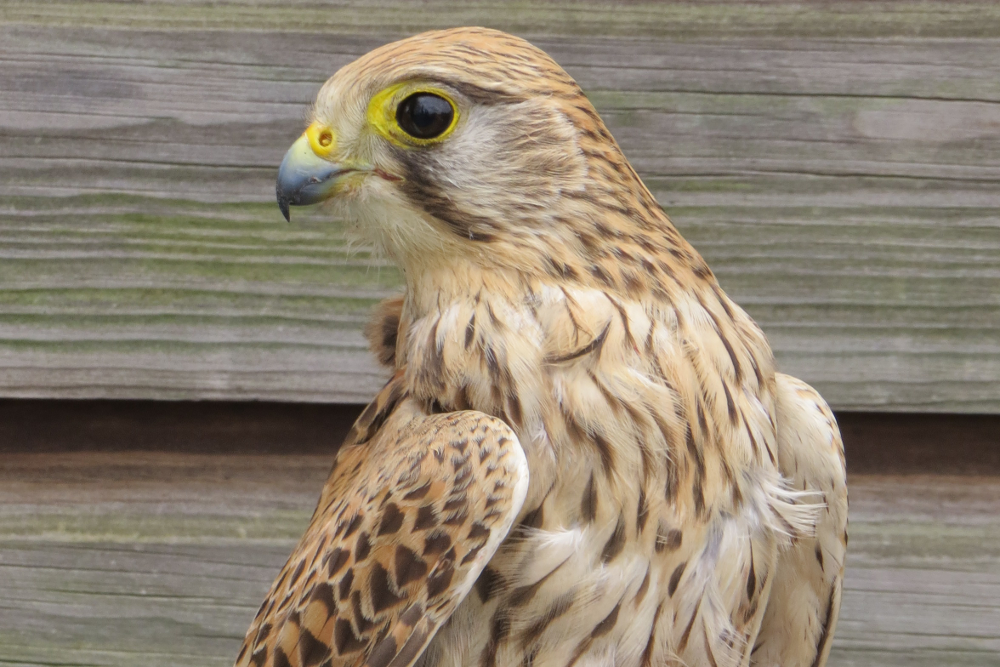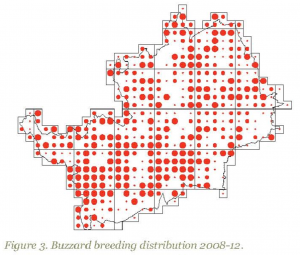
Review of Raptors at Rye Meads
One of the most striking changes of all bird groups in the south east, and indeed further afield, has been that of raptors. At Rye Meads, bird sightings have been logged whenever coverage by a Ringing Group member has been sufficient, this is about once or twice a week, since the late 1950s – that’s a lot of ‘Bird logs’!
Changes in raptors have been considerable, with regards to both population change and distribution. Fourteen species of raptor have been recorded at Rye Meads over the years, 82% of all raptors recorded in Hertfordshire (17 species). These species are reviewed below.
At Rye Meads there are those species which pass through occasionally, whether during migration periods or as winter wanderers. Honey Buzzard, Hen Harrier and Merlin are rarities with five or less records for each, and whose status remains unchanged. These are the species which cause great excitement amongst the regular members! There are also those species which really send panic into full force – Goshawk, seen on only two days in the Group’s history: two birds flying through on 2nd April 1999 and later in the month, a third individual flew over on 17th April 1999. Another example of such a species is the White-tailed Eagle, a first year bird which flew over on 11th February 2012, gifting some of the group with amazing views as it cruised low overhead. This is the only record of the species. On 25th May 2013 a Montagu’s Harrier flew north over the meadows, the fourteenth raptor species for Rye Meads.
Regular, annual passage migrants, Osprey and Marsh Harrier have shown some interesting trends over the years at Rye Meads, both species being seen more regularly nowadays. The first Osprey recorded at Rye Meads was on 24th May 1964. In line with increases in Scotland, and now further afield, in Wales and England, sightings at Rye Meads have increased. From that first record to 2000 there were 14 records, most of which were during spring passage, peaking in late April to early May. All records have been brief, with the exception of one bird in June 1995, which passed over with a fish! In the autumn, September is your best chance of seeing an Osprey at Rye Meads. At the Hertfordshire county scale, pre-1958 there were 18 records, from 1958 to 1982 there were 41, that’s 1.6 birds per year. From 1983 to 2012 this figure rose to 8.5 birds per year! There is no doubt the number of birds has increased, but so too has the number of observers. Another interesting find from recording Osprey over the years in Hertfordshire is that spring passage is advancing – from May in 1958/82 to April in more recent years. The September peaks in autumn remain unchanged. A male Marsh Harrier on 17th April 1979 was the first record for Rye Meads, followed by one on 22nd April the same year. There were then 18 records to 2000 during spring and autumn passage. The first lingering bird was a young male recorded in the meadows from 6th to 8th May 1994. In the UK, there was a single pair of Marsh Harriers in 1971, but this number has increased to some 400 pairs today! An increasing species, especially in south-east England, so we were thrilled to see a female bird lingering for most of the summer in 2013 and, as I write this, there are signs of a young male bird lingering at Rye Meads. Promising signs for the site and Marsh Harriers.
Onwards now to those species which barely receive a nod ‘hello’ from the regulars, but for which we have historic data documenting their population and distribution changes over the years: species which arguably tell us the most. Let’s start with an obvious one: Red Kite. The first breeding birds in Hertfordshire were recorded in 2005 after reintroduction projects in areas such as the Chilterns, though tagging projects show birds have arrived in Hertfordshire from a variety of reintroduction projects up and down the UK. The distribution in the county is biased towards the west. At Rye Meads, there were just three site records before 2004; May 2001, March 2002 and December 2004, nowadays they are recorded at Rye Meads pretty much every week!
 Another success story can be told about the Sparrowhawk. Back in 1962 there were only two records of Sparrowhawk at Rye Meads, on 15th January and 14th September; this was followed by a 16 year gap with none recorded – hard to imagine now! Sparrowhawks in the UK suffered catastrophic declines since the 1950s when pesticide use, such as DDT, caused thinning of egg shells and direct mortality of birds. Once these chemicals were phased out, Sparrowhawk numbers started to increase. In 1979 a bird was recorded on 3rd and 11th March and there was one record in October 1980. Slowly, the Sparrowhawk was making a comeback. By 1986 records were monthly, breeding was recorded near Rye Meads in 1991 but it wasn’t until 2004 that they were first recorded nesting on site! Worryingly, the Birds of Hertfordshire suggests that there has been a decline in records from the central and northern parts of the county, with the lack of passerine prey being suggested as an influencing factor – one to watch!
Another success story can be told about the Sparrowhawk. Back in 1962 there were only two records of Sparrowhawk at Rye Meads, on 15th January and 14th September; this was followed by a 16 year gap with none recorded – hard to imagine now! Sparrowhawks in the UK suffered catastrophic declines since the 1950s when pesticide use, such as DDT, caused thinning of egg shells and direct mortality of birds. Once these chemicals were phased out, Sparrowhawk numbers started to increase. In 1979 a bird was recorded on 3rd and 11th March and there was one record in October 1980. Slowly, the Sparrowhawk was making a comeback. By 1986 records were monthly, breeding was recorded near Rye Meads in 1991 but it wasn’t until 2004 that they were first recorded nesting on site! Worryingly, the Birds of Hertfordshire suggests that there has been a decline in records from the central and northern parts of the county, with the lack of passerine prey being suggested as an influencing factor – one to watch!


Another species for which we have seen an increase is Common Buzzard. This species was extinct in the county by 1965 but returned of their own accord as persecution decreased, were first proved breeding in the county in 1996, and are now estimated to be in the region of 1,000 pairs! At Rye Meads, the first ‘returning’ Buzzard was recorded in 1960 and was recorded throughout the autumn. The next record was in June 1975 and a second was seen in September that year. At first, records were most frequent in the autumn, but around the time the first birds were nesting in the county (1996), Rye Meads records became more evenly spaced between spring and autumn periods. By 2008 500 pairs were thought to be breeding in the county. The species continues to increase, with a maximum count of 17 recorded on 16th February 2014 and, although this species nests regularly only a stone’s throw from the site, the only nest on site was in 2011, when a pair reared one young.
Typically, Hobby returns to Rye Meads from the wintering grounds in southern Africa between late April and early May. Nowadays the species can be seen hunting over the site through the summer months, until their departure in September and early October. Hobbies were first recorded at Rye Meads in 1961 and 1962, followed by a 14 year gap. Thereafter single records were recorded sporadically over the years, this slow increase in sightings reflecting an increase in breeding in Hertfordshire. In recent years, day counts have very occasionally made it into the hefty heights of double figures!
Yet more good news for raptors at Rye Meads – the Peregrine. In 2000, in ‘The Birds of Rye Meads’, this species was described as an ‘increasing winter visitor and passage migrant’. Now Peregrines are described as an ‘increasing species at Rye Meads and breeds locally’. The first record was in 1959; after that, organo-chlorine pesticides wiped out the local populations and the next Peregrine was not recorded until autumn 1991, some 36 years later. These days, one or two birds are seen throughout the year, and Rye Meads is not short of pylons – a structure Peregrines are increasingly utilising for roosting and nesting, as the as the population increases country- and county-wide. One can dream…
The last species to cover here is the Kestrel. In 1962, the species was described as being ‘rarer than five years ago’: this would have been after the years of pesticide use which affected so many raptors, followed by the added hindrance of the harsh winters of 1961/62 and 1962/63, when Kestrel numbers were thought to be depressed. Kestrels continued to be recorded through these harsh times, and by the 1970s records were increasing on site. Kestrels have since nested on the Pylons, in old Crow nests, Kestrel boxes and more rarely, in natural cavities in trees on site. Post-fledging dispersal is high and once out the nest, young birds are not recorded on site for long! Our ringing data recorded just how unpredictable their dispersal can be: two siblings left the nest, one went to Scotland, the other was recovered locally. Nest site availability appears to limit numbers breeding at Rye Meads, with the majority of hunting occurring off site and nesting attempts being largely successful. Without ending on too much of a negative note, the Birds of Hertfordshire has flagged this species as potentially decreasing in the middle of the county, which reflects the national trend of a decline of 22% in England since 1967 (CBC/BBS trend) and a 40% decline across the UK as a whole since 1995 (BTO/JNCC/RSPB Breeding Bird Survey). Although this decrease has not been realised at Rye Meads yet, it is something to watch out for. The reasons behind this national decline are largely unknown, but are thought to be influenced by agricultural intensification, among other suggested factors being researched at the moment (such as impact from other raptors, rodenticides and roadside collisions).
The three other species we need to play ‘catch-up’ with are Black Kite, Rough-legged Buzzard and Red-footed Falcon, these having been seen in the county, but not at Rye Meads. If recent years are anything to go by, surely it is only a matter of time for the latter two! So, aside from the possible losses of Sparrowhawk and Kestrel in the county, the raptor scene at Rye Meads is looking pretty good. Let’s hope it stays that way and we’ll keep our eyes peeled for that Red-footed Falcon!
Most of the information for this blog was gleaned from The Birds of Rye Meads and The Birds of Hertfordshire. The maps showing distribution and population changes in Hertfordshire were taken from The Birds of Hertfordshire and kindly supplied by Mike Ilett of the Herts Bird Club. Both books are available to purchase and are an essential for any Hertfordshire birder’s bookshelf!
Sarah Harris, April 2016.
